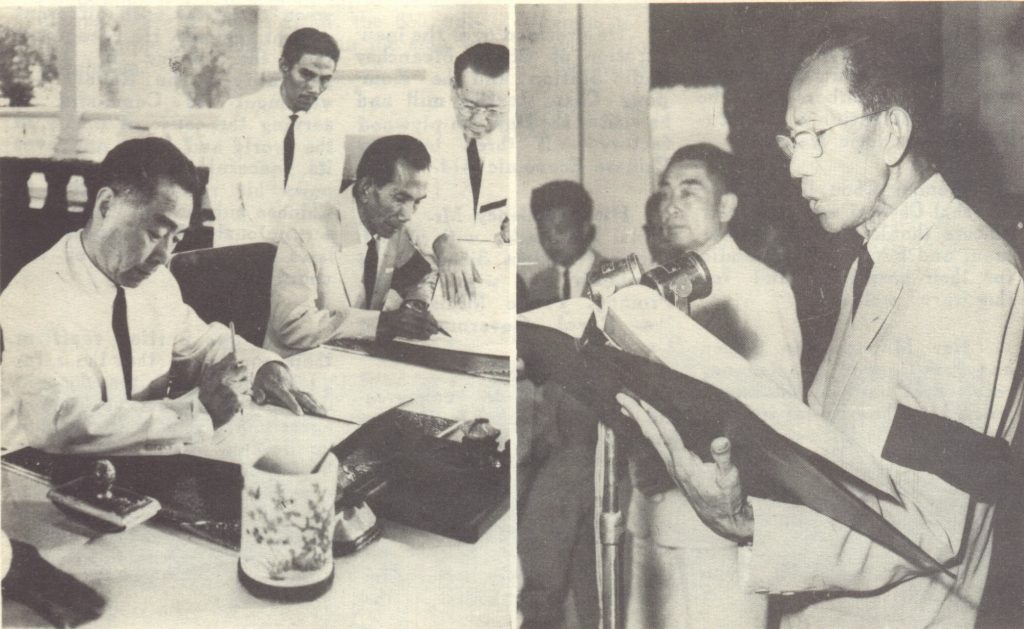On May 7, 1959, President Eisenhower sent the following personal message to Prince Sihanouk, who was, at the time in France. The letter was delivered to Nong Kimny for forwarding to Prince Sihanouk in Paris.
On May 8, 1954, delegates at the Geneva Conference began discussions on Indochina. The Viet Minh had achieved victory over the French Union forces at Dien Bien Phu the previous day. French Foreign Minister Georges-Augustin Bidault opened the conference by proposing a cessation of hostilities, a ceasefire, a release of prisoners, and a disarming of irregulars, despite the French surrender at Dien Bien Phu the day before.

On May 8, 1960, Chinese Premier Chou En-lai, on a state visit to Cambodia released a joint statement with Cambodian Prime Minister Pho Proleung.
During his visit to Cambodia, the premier of the People’s Republic of China observed with satisfaction the economic and social achievements of the Khmer people under the guidance of H.R.H. Prince Norodom Sihanouk of Cambodia and wished them more successes, in all spheres.
He presided over the inauguration of Stung Meanchey Radio Station and the Kompong Cham textile mill and he visited the Dey Eth plywood factory – all three built by Chinese Economic Aid. Read the full Joint Declaration HERE.

On May 8, 1970, President Nixon held a press conference defending his decision to authorize the invasion of Cambodia. He promised to withdraw 150,000 American soldiers by the following spring.
On May 9, 1969, The New York Times published details of Nixon’s ‘secret’ bombing campaign over Cambodia.
On May 9, 1970, SEALORDS- a combined South Vietnamese-U.S. naval task force proceeded up the Mekong River into Cambodia as part of the Cambodian Incursion. Its main objective wass to disrupt North Vietnamese and Viet Cong use of the river as an infiltration route into South Vietnam. The task force consisted of river patrol, assault, and transport boats as well as helicopters and fixed-wing aircraft.
South Vietnamese naval units reached Phnom Penh, while U.S. personnel stopped halfway at Neak Luong, securing the strategic Highway 1 river crossing over the Mekong. U.S. boats returned to South Vietnam by the end of June, but South Vietnamese forces continued to guard the Cambodian stretches of the Mekong through the summer of 1970.

On May 9, 1996, the Council of Ministers decided to establish formal diplomatic relations with South Korea. Cambodia and South Korea would first establish diplomatic missions – which would had lesser status than an embassy. Cambodia, through Sihanouk, had especially strong ties with North Korea, which began to wane soon after this announcement.
On May 10, 1954, in Geneva, Phạm Văn Đồng, the leader of the Democratic Republic of Vietnam (DRV) delegation set out their position, proposing a ceasefire; separation of the opposing forces; a ban on the introduction of new forces into Indochina; the exchange of prisoners; independence and sovereignty for Vietnam, Cambodia, and Laos; elections for unified governments in each country, the withdrawal of all foreign forces; and the inclusion of the Pathet Lao and Khmer Issarak representatives at the Conference.
On May 10, 1964, the French government delivered a squadron of AMX-13 tanks to the Cambodian government after agreeing to provide military aid the previous January.
On May 10, 1975, the Khmer Rouge occupied the Vietnamese island of Tho Chu. Around 500 civilian residents were taken away and killed. Vietnamese forces recaptured the island 2 weeks later.
On May 11, 1971, The New York Times reported “Authoritative sources said today that Angkor Wat, Cambodia’s national treasure and the most famous temple of the ruins of Angkor in northwestern Cambodia, had been severely damaged by Cambodian Army artillery barrage.
Reports of the shelling owe from travelers returning from Siemreap, the town nearest Angkor, which is controlled by anti‐Government forces. The reports were later confirmed by a Government expert who saw photographs of the damage.
The shelling was said to have killed or wounded about 10 peasant refugees in a nearby pagoda and to have heavily damaged the south side of the 12th‐century temple. The shelling occurred three months ago but has been kept secret by the Government, the informants said.
The temple, Cambodia’s national symbol, was occupied by Vietcong and North Vietnamese troops last June, after the war spread across Cambodia. Government forces were ordered not to attack for fear that fighting would destroy the temple.”
On May 11, 2015, ABA Bank officially launched ABA Mobile, the first full-scale mobile banking application in Cambodia.
On May 12, 1975, an American cargo vessel, the SS Mayaguez, is seized by Khmer Rouge gunboats off the Cambodian coast. The ship was taken to Koh Tang.

On May 13, 1813, Ang Chan II reclaimed the Cambodian throne with the aid of the Vietnamese. His brother, Ang Snguon who had been ruling as Ouprayorach under the Siamese escaped to Bangkok. This ended the Siamese occupation and another period of Vietnamese domination began.
On 13 May 1956, diplomatic relations between the Soviet Union and Cambodia were established.
On May 13, 2003, the United Nations General Assembly approved the agreement between the United Nations and
the Royal Government of Cambodia and appealed to the international community to provide assistance, including financial and
personnel support, to the Extraordinary Chambers (Khmer Rouge trials).
